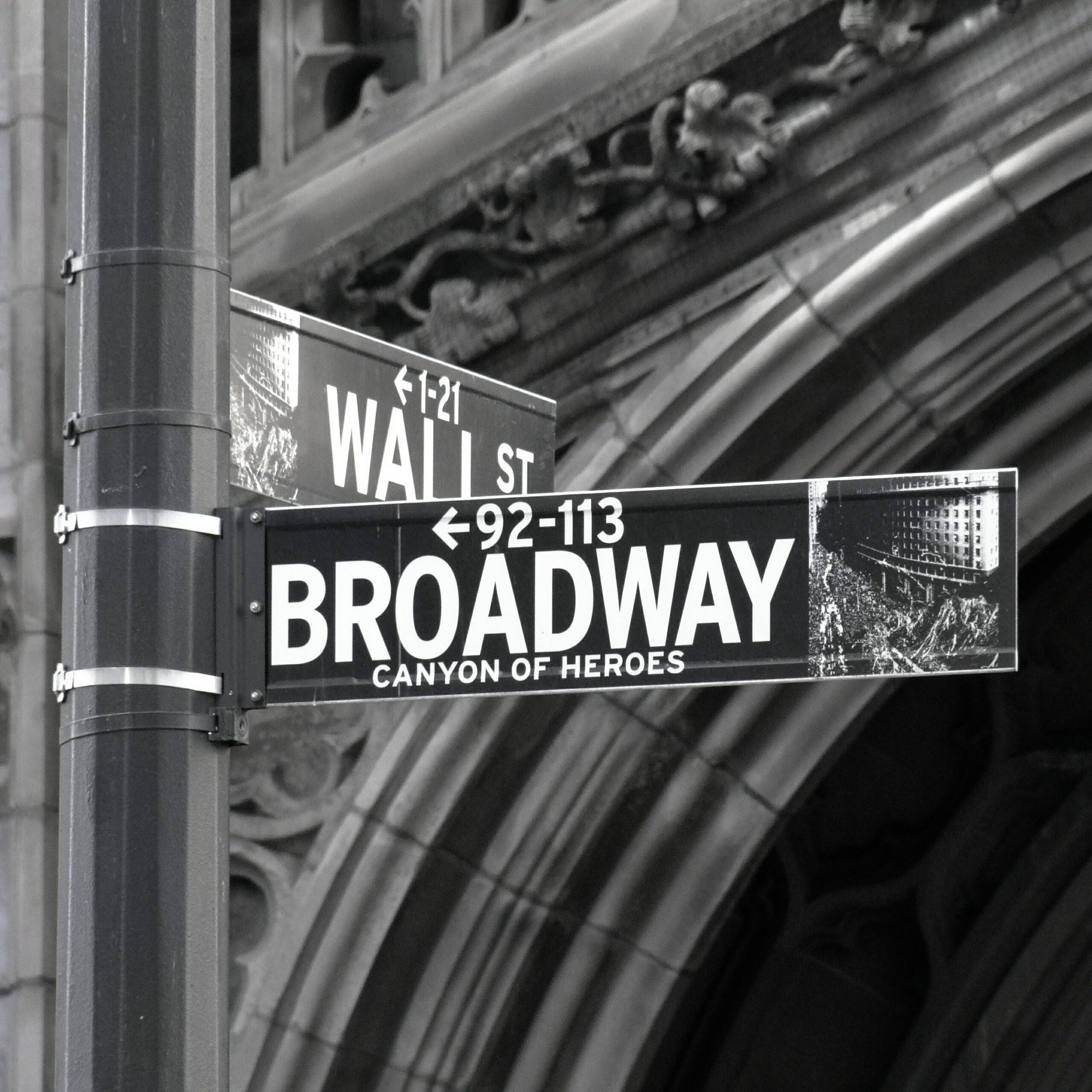
Broadway
Photo by Andy Willis on Unsplash
Near the end of the first act of Hadestown, the stage goes completely dark, save for an array of huge lamps swinging from hooks somewhere in the rafters.
They swirl around Orpheus (Reeve Carney), lighting his descent into hell. With each rotation, they narrowly avoid his body, instead spinning to the rhythm of the electrifying beautiful song that he’s singing, called “Wait for Me”—a song which we later find out made a crack in the wall, a crack that opens up a passage into the blinding lights of Hades’ industrial lair.
“Wait for Me” from the Broadway Production of Hadestownwww.youtube.com
As the show’s narrator, a version of the god Hermes, describes the treacherous journey to the underworld over an exhilarating backdrop of violins and drums, the set begins to change. Wooden walls open up and roll back to reveal the framework of Hadestown itself, consisting of pipes and blinding lights that throw the stage into stark relief.
It’s one of the most spine-chilling and seamless transitions in modern musical theatre history, so magnetic and moving in fact, that the audience cheered for around a full minute after the set change was complete. It’s also one of many meticulously orchestrated moments in Broadway’s most innovative show. That’s Hadestown for you, though. The show is equal parts technical precision and raw emotion, winding mythology and searing social commentary into a kaleidoscopic carnival.
Hadestown is the project of singer-songwriter Anaïs Mitchell, who began writing it over a decade ago. She first performed the show on a bus in Vermont, touring around schools and using the songs to teach kids about the myths of Hades, Persephone, Orpheus, and Eurydice.
Sometimes, even in a theater in the heart of Times Square, you can almost feel the remnants of the songs’ beginnings on that bus—a closeness to the land, the rhythm of wheels turning on uneven terrain, the emptiness that defines so much of the American landscape. That closeness to the earth, and the show’s intimate connection to real struggles faced by everyday people, are unexpected on a stage that usually celebrates glitz and glamor and in a show about ancient Greek myths.
Hadestown winds together two old tragedies: the stories of Hades and Persephone, and Orpheus and Eurydice. In the first myth, Hades steals Persephone away while she’s playing in a field. Due to the protestations of her mother, the earth goddess Demeter, Hades agrees to let Persephone return to earth for six months out of the year—and so summer was born.
In the Orpheus and Eurydice myth, Orpheus follows his lover down to Hades after her death. After enchanting Hades with his music, the god of death agrees to let them go—if Orpheus can make it home without looking back to see if Eurydice is following.
Mitchell’s reinterpretation, enhanced by brilliant directing from Rachel Chavkin, transfers these myths to a modern-day setting, painting Hades’ underworld as a walled factory-wasteland filled with dead-eyed workers forever constructing a wall, “punching in and punching in and punching in” for all of eternity.
Eurydice, played by the extraordinary Eva Noblezada, is a jaded runaway who falls for Orpheus after he makes a red flower bloom with his music. Their love is strong in the summer, when Persephone is back “living it up on top” and food is abundant, but by winter Eurydice grows frustrated by hunger and Orpheus’s disconnect from reality, and finally agrees to go work in Hadestown in exchange for what is essentially eternal job security. Naturally, Orpheus—directed by the silver-clad god Hermes, who serves as his guardian as well as the show’s narrator—follows her into the underworld.
Hermes and the three fates, who float gracefully around the stage and sing in heart-stopping harmony, are instrumental to the show’s rhythms, pumping real magic into the music. When Orpheus sings his epics, his voice is stark at first against the sound of just his electric guitar, but soon harmonies seem to grow up from the shadows themselves, followed by a haze of warm piano, ghostly violins, and a virtuosic trombonist. “[Orpheus] could make you see how the world could be, instead of how it is,” repeats Hermes throughout the show, and when you hear the music rise to its full heights, it’s hard not to share in that vision.
Hadestown, on the whole, doesn’t shy away from showing you how the world is—but it also shows you how it could be, painting that world with its soft lighting and bittersweet poetry. Ultimately, it’s an example of the transcendent works of art that human beings are capable of creating, using ancient stories and melodies to tap into the universal stories that connect us all and hint at the existence of much larger, even divine forces.
Despite its grandiose foundations, Hadestown is so game-changing because of how relevant it is to modern life, and how intimately it explores the deepest human experiences we share. Essentially, it’s a show about working, about greed and struggle, about love in the midst of hunger and poverty; and perhaps most of all, it’s a critique of capitalism. It’s a damnation of the American ethos of greed and unchecked consumption that lift up the super-wealthy while leaving the poor in the dust, an ethos that has generated the wastefulness that created the modern environmental crisis. This is what makes the show so radical, radical enough that it may be the start of a pronounced change on Broadway and in musical theatre on the whole.
That’s not to say that Hadestown doesn’t also offer an escape. On the contrary, the whole production is so captivating that you hardly know where to look and at times may forget how to breathe. But it also reaches beyond the cloistered walls of New York’s bubble of liberalism, beyond Broadway and Hollywood’s tendency to worship the glamorous and the gilded, instead of approaching the reality we’re all actually living in—of course, through the lens of Mitchell’s finely wrought poetry and virtuosic compositions.
That reality becomes apparent when, just after Orpheus enters Hades, the god of death leads his workers in a song called “Why We Build the Wall.” It’s impossible not to think of Donald Trump when the chorus rings out, “Why do we build the wall?” croons Hades, and the crowd of faceless workers chants, “The wall keeps out the enemy / and the enemy is poverty / and we build the wall to keep us free.” Mitchell actually wrote the song way back in 2006, but it’s a stunning protest anthem for right now, one that laments the evil hypocrisy of a capitalist society that hoards wealth, exploits its own workers, and rejects its weakest citizens who cannot keep up with its relentless pressures. With every day brings another revelation about the state of the US-Mexico border—from the removal of protections for asylees seeking protection from domestic violence to the family separations and children’s deaths at the hands of ICE—the song feels like a searing indictment of this border wall and all of the American exceptionalism and greed that it symbolizes.
Hadestown: Why We Build The Wall #NoWallswww.youtube.com
In spite of this, “Why We Build the Wall” and Hadestown, on the whole, are not located in any specific time period or place, and the show never expresses an us-against-them sentiment. Instead, it humanizes even Hades. “The heart of a king loves everything like the hammer loves the nail,” Orpheus sings, as part of his plea to Hades. “But the heart of a man is a simple one, small and soft, flesh and blood…What has become of the heart of that man? Now that the man is king? Now that he has everything?”
So Hadestown is not an overt damnation of Trump. It is, however, a rousing call to protest even in the face of seemingly indomitable evil. “If it’s true what they say, then I’ll be on my way,” sings Orpheus, considering the futility of his task. “But the ones who deal the cards / Are the ones who take the tricks / With their hands over their hearts / While we play the game they fix.” His hope inspires other factory workers to look up from their machinery, and eventually wins him and Eurydice passage out of Hadestown. It is a doomed passage, of course, as Hermes tells us from the beginning, the inevitable ending of a very old story that has always ended in tragedy.
13 – If It’s True (Anaïs Mitchell – Hadestown)www.youtube.com
At its heart, Hadestown asks why human beings keep singing, creating, and falling in love despite knowing that it all might be useless in the end. It asks why we bother to speak out when individual protests and art seem so futile, and when forces like capitalism and climate change seem too vast and overwhelming to comprehend, let alone fight. “Cause here’s the thing,” Hermes says at the very end of the show, just before launching back into the opening number. “To know how it ends, and still to begin to sing it again, as if it might turn out different this time…”
Ultimately, Hadestown doesn’t promise that if we just hope a little harder, everything will be fixed. But it does, in Mitchell’s words, raise a glass to the ones who try.
Eden Arielle Gordon is a writer and musician from New York. Follow her on Twitter @edenarielmusic.
POP⚡DUST | Read More…
AOC Shows Us “How You Win Everything” on Netflix’s “Knock Down the House”
Watch Kate McKinnon Play an Evil Queen in “Heads Will Roll” Teasers
Happy #LesbianVisibilityDay: 10 Queer Artists Who Are Changing the Industry
- Is Biden’s New Website Hot or Am I Just Desperate? – Popdust ›
- Is Joe Biden’s Website Hot or Am I Just Desperate? – Popdust ›
- The Best Moments from the 2019 Tonys – Popdust ›
- ‘Hadestown’ Tries Like Hell to Spin a Concept Album on Broadway … ›
- ‘Hadestown’ Review: A Musical Heats Up Broadway – WSJ ›
- Read Reviews for Hadestown’s Pre-Broadway Engagement in London ›
- U.K. Review: “Hadestown” at the National Theatre — OnStage Blog ›
- Did the critics enjoy their trip to Hadestown at the National Theatre … ›
- Hadestown Broadway Reviews – Critics Ratings ›
- HADESTOWN ›
- ‘Hadestown’ Review: Musical at London’s National Theatre – Variety ›
- 300+ Hadestown (Broadway) Reviews, Discount Hadestown … ›
- Review: ‘Hadestown’ Reanimates a Well-Known Myth – The New … ›













